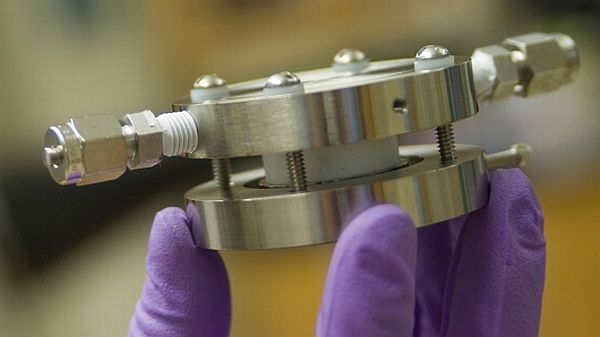 Lithium-air batteries were proposed for vehicular propulsion in the 1970s because of their potentially high specific power and high specific energy. More recently, these batteries have attracted attention for military applications. Lithium provides the highest specific energy, compared to any of the common metals used in metal/air batteries. Furthermore, Li-air batteries are capable of achieving high specific power under well-controlled conditions.
Lithium-air batteries were proposed for vehicular propulsion in the 1970s because of their potentially high specific power and high specific energy. More recently, these batteries have attracted attention for military applications. Lithium provides the highest specific energy, compared to any of the common metals used in metal/air batteries. Furthermore, Li-air batteries are capable of achieving high specific power under well-controlled conditions.
Because of the reactivity of Lithium with water, Li-air batteries with aqueous electrolyte cannot be electrically recharged.
What is Li-air battery?
Lithium-air batteries are complex electrochemical systems consisting of a porous electrode allowing oxygen from the air to be reduced, a negative electrode of a pure lithium metal and an electrolyte which is an organic solvent with a lithium salt. This combination gives a high energy density. Lithium-air cells operate at reasonably high coulombic efficiencies because of the relative chemical stability of Lithium in water. The in situ formation of a surface oxide (hydroxide) film on lithium metal retards rapid corrosion after the surface film is formed. However, at open circuit potentials corrosion is rapid, resulting in low electrochemical efficiencies. Thus, the electrolyte is drained from these cell during standby.
How does it work?
The typical operating temperature of alkaline Lithium-air batteries is limited to less than 100° C because of the vapor pressure of the aqueous electrolyte and the low melting point (179° C) of lithium. The cathode in a lithium-air or lithium-oxygen battery constitutes a complex chemical system and the desired electrochemical reactions only take place at the preferred sites. These sites are known as three phase boundaries, where the presence of oxygen (gas phase), carbon (solid phase) and electrolyte (liquid phase) are connected. Some parameters which have shown to influence the lithium-oxygen battery performance are the type of carbon and binder used in the cathode, the electrode composition and its porosity, the oxygen solubility and the electrolyte composition. When pure and dry oxygen is used, two discharge reactions take place:
2Li + O2 —–> Li2O2 ( E0 = 3.10 V )
4Li + O2 —–> 2Li2O ( E0 = 2.91 V)
Cathode reaction: H2O + e- —-> OH- + 1/2 H2
Latest development:
The electrolyte vaporization and anode hydrolysis are limiting the capacity of Lithium-air batteries, therefore different ionic hydrophobic liquids have been investigated due to their resistance to water and low evaporation rates. Lithium-air batteries have been modified nowadays, which combine the properties of a molten-salt battery and a solid electrolyte fuel cell. These cells would surely bring out a green revolution.




